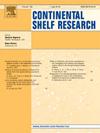Characterization of two channels of the Chiloé Inland sea used by aquaculture farming: An observational approach to water exchange
IF 2.2
3区 地球科学
Q2 OCEANOGRAPHY
引用次数: 0
Abstract
This study characterizes the hydrodynamics of the Dalcahue and Yal channels, key aquaculture areas within the Chiloé Inland Sea (CIS). It demonstrates the significant influence of bathymetric constrictions on local circulation patterns, tidal modulation, and biogeochemical variability. Dalcahue exhibits distinct bidirectional residual flows, characterized by intensified central inflows (NW-NE) and reinforced outflows (SE-SW) along the Quinchao coast, driven by channel curvature and bathymetry, with velocities reaching up to 70 cm/s in constrictions. In contrast, Yal shows a weak surface residual layer and persistent northwestward mid-depth flow, indicative of vertical tidal energy variations. Semidiurnal tidal forcing (M2, S2) predominantly drives current variability, explaining 50–75 % of observed fluctuations. A significant presence of the M4 overtide (up to 33 % in C2) highlights non-linear tidal interactions, crucial for understanding tidal asymmetry and net material transport. Weak correlations between sea level and dissolved oxygen suggest that strong tidal currents and mixing in constrictions counteract stratification, ventilating deeper layers. These findings enhance our understanding of physical oceanography in the context of the CIS, providing vital insights for environmental management and aquaculture planning by highlighting the role of constriction-induced hydrodynamics in estuarine systems worldwide.
chilo内海水产养殖用两条渠道的特征:水交换的观测方法
本研究描述了chilo内海(CIS)内主要水产养殖区Dalcahue和Yal河道的水动力学特征。它证明了水深收缩对局部环流模式、潮汐调制和生物地球化学变异的显著影响。达尔卡休表现出明显的双向残余流,其特征是在通道曲率和水深测量的驱动下,沿昆潮海岸中心流入(NW-NE)增强,流出(SE-SW)增强,收缩时速度可达70厘米/秒。而Yal则表现出微弱的表层残留层和持续的西北中深流,表明垂直潮能的变化。半日潮强迫(M2, S2)主要驱动洋流变率,解释了观测到的波动的50 - 75%。M4溢出的显著存在(在C2中高达33%)突出了非线性潮汐相互作用,这对于理解潮汐不对称性和净物质输送至关重要。海平面和溶解氧之间的弱相关性表明,强烈的潮汐流和收缩的混合抵消了分层,使更深的层通风。这些发现增强了我们在CIS背景下对物理海洋学的理解,通过强调收缩引起的水动力学在全球河口系统中的作用,为环境管理和水产养殖规划提供了重要的见解。
本文章由计算机程序翻译,如有差异,请以英文原文为准。
求助全文
约1分钟内获得全文
求助全文
来源期刊

Continental Shelf Research
地学-海洋学
CiteScore
4.30
自引率
4.30%
发文量
136
审稿时长
6.1 months
期刊介绍:
Continental Shelf Research publishes articles dealing with the biological, chemical, geological and physical oceanography of the shallow marine environment, from coastal and estuarine waters out to the shelf break. The continental shelf is a critical environment within the land-ocean continuum, and many processes, functions and problems in the continental shelf are driven by terrestrial inputs transported through the rivers and estuaries to the coastal and continental shelf areas. Manuscripts that deal with these topics must make a clear link to the continental shelf. Examples of research areas include:
Physical sedimentology and geomorphology
Geochemistry of the coastal ocean (inorganic and organic)
Marine environment and anthropogenic effects
Interaction of physical dynamics with natural and manmade shoreline features
Benthic, phytoplankton and zooplankton ecology
Coastal water and sediment quality, and ecosystem health
Benthic-pelagic coupling (physical and biogeochemical)
Interactions between physical dynamics (waves, currents, mixing, etc.) and biogeochemical cycles
Estuarine, coastal and shelf sea modelling and process studies.
 求助内容:
求助内容: 应助结果提醒方式:
应助结果提醒方式:


